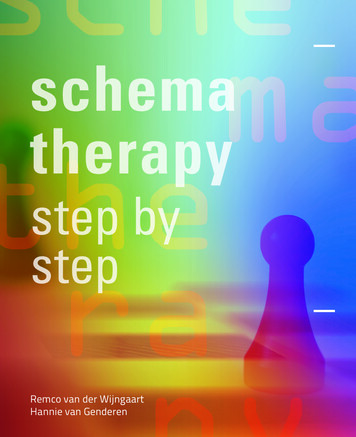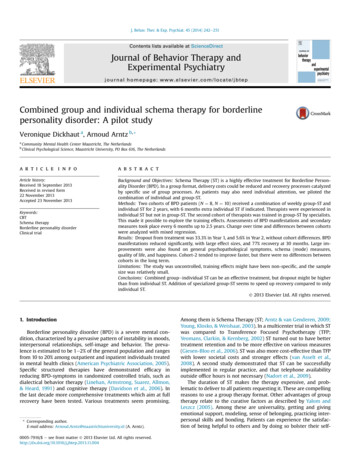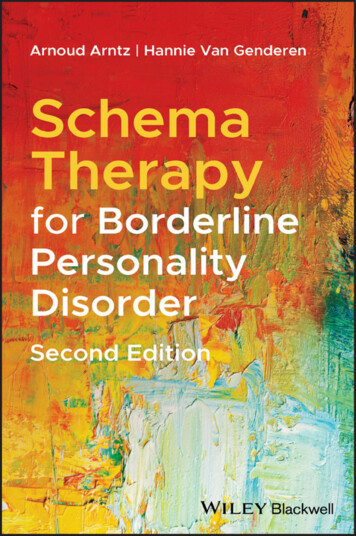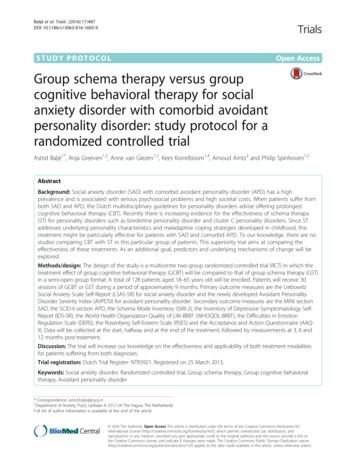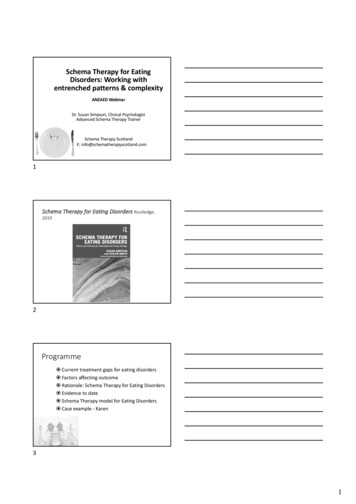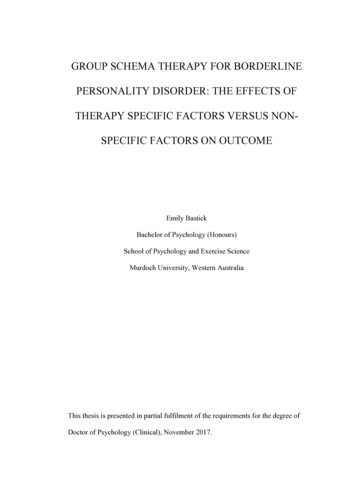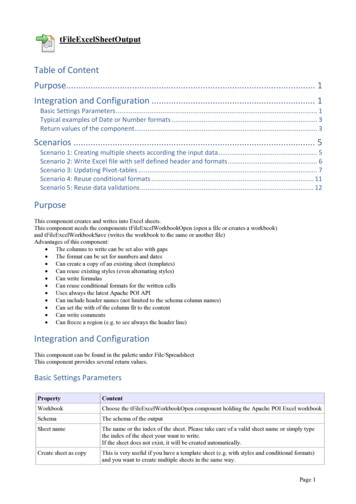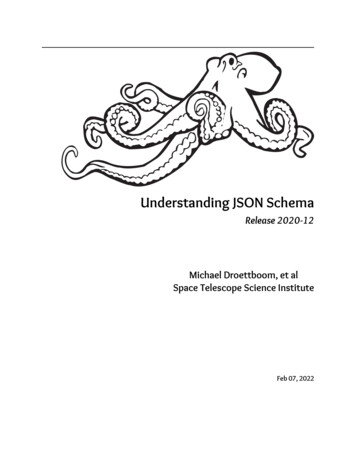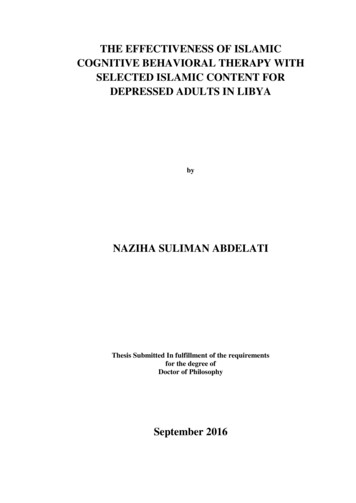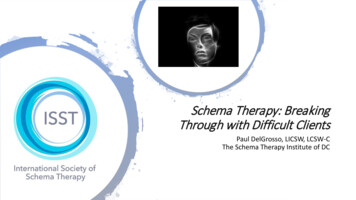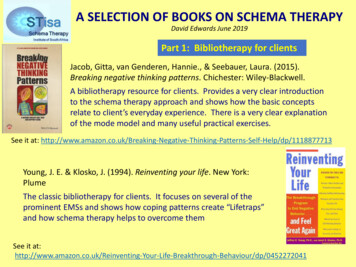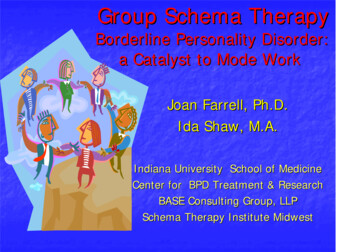
Transcription
Group Schema TherapyBorderline Personality Disorder:a Catalyst to Mode WorkJoan Farrell, Ph.D.Ida Shaw, M.A.Indiana University School of MedicineCenter for BPD Treatment & ResearchBASE Consulting Group, LLPSchema Therapy Institute Midwest
OUR BACKGROUNDSJoanIda Psychodynamic – U of DevelopmentalMichigan 1968-72Psychology – U ofWindsor 1967-70, Behavioral – WSU 1982-51972-1978 Bioenergetics – 1975 Personal1985construct/Sociallearning – Low 1975 Core Energetics –1980s Experiential –Bioenergetics 1981-85INTEGRATION BEGAN IN 1985CONTINUES FOR 25 YEARS
Marsha Linehan’s firstarticle on DialecticalBehavior Therapy inthe Bulletin of theMenninger Clinic.Michael Stone’s longterm follow-up studyof BPD patients givesa grim prognosis forthe disorder.1986Larue CarterFarrell, Shaw & Glennonform a study group todevelop an effectivetreatment plan for aninpatient Debby B.with BPD who couldnot stay in a sessionfor more than 10minutes due toextreme distress.
st1ChallengeHigh Distress LevelThey were too distressed to stay inone place for more than 10 minutes.Solved with physical movement,kinesthetic awareness exercises &relaxation
nd2ChallengeLow level ofEmotionalAwarenessThey did not notice pre-crisislevels of distress – globalgood & badThey seemed to have nowords to describe theiremotional experience,making verbalpsychotherapy difficultThey were missing criticalemotional learning
EMOTIONAL AWARENESS1987 – Levels of Emotional Awareness,Lane & Schwartz, American Journal ofPsychiatry1988 – Techniques to increase emotionalstability in Borderline PersonalityDisorder patients, Farrell, Shaw &Glennon. APA Midwinter Conference onPsychotherapy, Scottsdale AZ1994 – Emotional Awareness Training: Aprerequisite to Effective CB treatmentfor BPD , Farrell & Shaw, Cognitive &Behavioral PracticeExperientialtechniquesin CBT andTherapyIntegrationwere justbeginning.
THE ALL BPD GROUP: ORDEALOR OPPORTUNITY?1988 – Larue CarterOutpatient Clinic group,weekly 90 minutesessions, one year.We learned just how muchindividualization theyneeded and that we couldnot use their reactions as agauge of effectiveness.It took 6 months to get theminto the same room for asession.
3rd Challenge: They did not useskills outside of sessions!Schemas (self-defeating core themes orpatterns) of defectiveness, vulnerability,failure, mistrust/abuse, etc. keep themfrom using their increased awareness orhealthy coping skills that we taught them.
OUR EARLY GROUP MODEL Limited re-parentingMatch developmental stage – emotionalStrong focus on experiential work –Gestalt, Bioenergetics (kinesthetic),Imagery via breath-workTechnically eclectic – unified guidingtheory – social learning, person construct
ST1GROUP MODEL3 BASIC COMPONENTS:1. Effective emergency plans(mode management plans)2. Adequate emotional awareness(awareness of needs, feelings, modes)3. Free enough of maladaptive schemas totake adaptive action (Healthy Adult)4. We thought of this as “foundation work”
1990 First Schema Therapy WritingCognitive Therapy for PersonalityDisorders – Schema FocusedApproach, Jeffrey YoungAnd the first CBT treatment for PD:Cognitive Therapy for PersonalityDisorders. Beck, Freeman, et alIncludes : BPD Chapterby Arnoud Arntz
RANDOMIZEDCONTROLLED TRIALNIMH RO3OUTPATIENT LC Adjunct to individual BASE vs. TAUtherapy N 32 8 months, 30 sessions 100% retention intreatment group 90 minutes long 1 session/week No outside groupcontact 6 month follow-up
GROUP ST VS TAU FOR BPDMAIN OUTCOME MEASURES (FARRELL & SHAW, 2009)Mean ESCohen’s dST 2.62TAU 0.04RecoveryST 94%TAU 25%Drop-OutST 0 %TAU 25%Farrell et al. (2009),J. Beh. Ther. & Exp.Psychiatry.
INPATIENT ST PROGRAM 1998Phase I Open Trial 2004-2007 N 42Limited re-parenting milieuCo-therapists in groupsStrong, consistent team15 weekly group sessions1 hour of individual therapy3 – 6 months long (mean 4.5)6 month & 1 year follow-up
INPATIENT PILOT TREATMENT PROGRAMSchema Therapy Groups – 10hrs per weekConducted by 2 trained co-therapists Psychoeducation - about BPD & Schema therapy -1hrSchema Therapy -2 hrsSchema Skills -2 hrsCognitive Mode Work -1hrExperiential Mode Work -1hrMode Management Plans -1hrMode Awareness -1hrModes in Interaction -1hrIndividual Schema Therapy session – 1hr per week
RECOVERY FROM BPD IS POSSIBLEInpatientPilotN 42BSI SCORESBPD BSI 25TIMEADMISSION87%t 13.84(41), p .01Mean GAF28POST15%ES 2.1458t -17.55(36), p .01 ES 2.89OUTPATIENTRCT N 32SCHEMATHERAPYTAUPost6 monthPost6 month94%100% 25%17%56%88%8%TIME% NolongermeetingtheDIB-R cutoff scorefor BPDGAF 6017%ES - Effect sizes using pooled SDs at baseline and mean change scores per condition.Cohen’s d.
PATIENT SATISFACTIONIn anonymous questionnaires Patients rated theiroverall satisfaction with the treatment as apercentage. The mean percentage rating was92%They were also asked to report what was mosthelpful to them in order of priority with thefollowing result: 17 “The feeling of belonging”“I felt understood for the first time”“There are people like me, so there is hope!”“Therapists were patient & consistent”“Therapists did not give up on me”“Learning effective coping skills”
MEAN TREATMENT EFFECT SIZESFOR BPD rntz, 2010
DROP-OUT COMPAREDSTUDIES COMBINED BY MODEL% DROP-OUT AT YEAR 110090807060504030GROUP ST0%20100DBTGSTSFTTFPMBTCONTROLArntz, 2010
BY 2008, WE DECIDE THAT OURMODEL WAS A GROUP VERSION OFSCHEMA THERAPY FOR BPD.YOUNG & ARNTZ AGREE SO WE JOIN THE INTERNATIONALSCHEMA THERAPY RESEARCH &PRACTICE COMMUNITY
CAN OUR RESULTSBE REPLICATED?USA INPATIENT PILOTDUTCH PILOTS
Pilots :Group & Individual ST Compared toRCT 1 Individual ST & RCT 2 Group ST40Effect Sizes Cohen’s d35BPDSI30group 1group 2RCT2520RCT 2BSIDIB15Group 1: Dickhaut & Arntz, 20106 months 1.2812 months 2.40Group 2: Dickhaut & Arntz, 20106 months 2.25IND RCT1 Giesen-B, Arntz, 20066 months 0.7512 months 1.1010pre6 months 8 MOS12 months14 MOSGroup RCT2 Farrell-Shaw, 20098 months: 2.48, 4.2914 months: 2.96, 4.45PRELIMINARY EVIDENCE THAT GROUP RCT EFFECTS ARE REPLICABLE !!
WHY SUCH The Curative Factors ofgroups directly address theLARGEmain schema issues ofEFFECT SIZES? patients with BPD (and manyPDs). Group Catalyzes or AugmentsSchema Therapy’s activeingredients – limitedreparenting, secureattachment, emotionallearning, schema modechange, generalization andtransition to Healthy Adultfunction
GROUP SCHEMATHERAPY BENEFITSFROM THE POWER OFTHE GROUPBECAUSE IT GOESBEYOND DOINGINDIVIDUAL THERAPYWHILE A GROUPPRIMARILY WATCHES
Group Curative Factors Schemas of BPDCohesiveness (belonging) AbandonmentCorrective recapitulation Mistrust /abuseof the primary family PunitivenessAltruism Unrelenting standardsInstallation of hope Defectiveness/shameUniversality Emotional deprivationImparting of information Social Isolation/alienationDevelopment of Undeveloped selfsocializing techniques Emotional InhibitionInterpersonal learningVicarious learningRELATIONSHIP BETWEENExistential factorsCURATIVE FACTORS & BPDCatharsisSCHEMAS
TO ACTIVATE GROUPCURATIVE FACTORSgroup work must be asimportant as individualwork.Ways we accomplish this include: Individualpatient focus is time limited and made salientfor the group as a whole Focus moves between an individual’s experience andmodes common to the group We “weave” the common experiences of others intoindividual work & pull for group involvement One therapist is always attending to maintainingconnection and the needs of the group.
GROUP CATALYZES ST COMPONENTS2. Schema Change Bigger stage for experiential Vicarious learning powerfulin getting through DP The experience ofbelonging in the peer“family” is powerfullyhealing VC Mode role-play with “full3. Autonomychairs” strengthens impact Group acts as a “bridge” to life outside therapy “Adolescent” level Mode work1. Limited Reparenting Experiences with peersfeel more “real”. Closer analogue of thefamily may intensifyexperiential work Extended Familyreparenting effects
GROUP ST MODEL #2 ADDED MODESAbandonmentFearsIntenseMODEangerTHEpoor controlMODELPROVIDESImpulsiveYOUWITHbehaviorTHE FOCIOFTREATMENTTOSIB, eChildPunitive orDemandingParentDetachedProtectorMODE able selfPRESENTATION ction DissociationPsychoticsymptoms
MODE CHANGE IN GROUP ST2 THERAPISTSDEMANDINGANGRY CHILD CHANNELEDANGRY – IMPULSIVECHILD MODESIMPULSIVE CHILD LIMITEDPPUNITIVE &MDEMANDINGAPARENTSOBANISHEDRENTTHE GROUPVULNERABLECHILDDESPUNITIVEGROUP AS BRIDGEDETACHED PROTECTORGOOD QUALITY OF LIFEHEALTHY ADULTHAPPYCHILDDEVELOPS
GroupSchema TherapyThe theoretical model, the course &components are consistent with individualSchema Therapy (Young, 2003; Arntz, 2009)Group requires some differences in application Limited reparenting of a large family vs. only child– multiple and at times conflicting needs existCo- therapist team leads – a strong workingrelationship between therapists is neededGreater complexity – more modes simultaneouslyMore balancing of structure & flexibility are needed
WHICH STRUCTURAL MODEL OFGROUP THERAPY IS GST? Interpersonal or ProcessgroupPerson-oriented groupPsychoeducation, Skills,disorder specific groupA new integrative model
Person-oriented GroupInteraction or Process GroupsPsyched & Disorder-specific GroupsTherapistGST INTEGRATESASPECTSOF OTHERMODELSWITH THERAPISTINVOLVEMENTPROTAGONISTPsychoanalytic groupsTherapistGestalt(Perls)Encounter (Rogers)“SAFETY BUBBLE”Psychodrama(Moreno)Interpersonal (Yalom)Problem-solvingTherapyManualized grouptherapy forAdaptedFarrell from& Shaw(D‘Zurilla)specificdisorders: Depression,Sipos & SchweigerHigh(Beck)emotionsandconflictdesired hobia,etc. are
THE COURSE OF GROUP ST Orientation, psychoeducationSafety - establish safe group environmentBonding– with therapist & groupStabilize – life threatening behaviorMode Change: Assess: symptoms & their modes Get through/around coping modesHeal Abandoned-Vulnerable child modeEliminate Punitive/demanding modeChannel Angry/Impulsive Child mode Autonomy Strengthen Healthy Adult modeDevelop Joyful Happy Child ModeLink to Peer Support
MAIN COMPONENTS OF GROUP OR INDIVIDUALSCHEMA THERAPY ARE THE SAME1. LIMITED REPARENTING2. MODE CHANGE – INTEGRATIVE EXPERIENTIAL WORK COGNITIVE IMAGERY WORKMODE ROLE PLAYSTRAUMA PROCESSINGREFRAMINGID DISTORTIONSBEHAVIORAL PATTERN BREAKINGHOWEVER, THEY ARE ADAPTED TO THE GROUP MODALITY
ANOTHER DIFFERENCE:Just as individual ST has phases, the PHASESin the life of a Group – must be recognized& either facilitated or managedSome similarity to the naturally occurringstages of process groups with moretherapist facilitation and limit setting.GROUP STAGES Bonding & Cohesiveness – strongfacilitationConflict – management and limit settingThe Working Group - facilitationAutonomy – but “well-connected”
THE FOUNDATION OF ALLSCHEMA THERAPY ISLIMITED REPARENTING*In Group Schema Therapy, this meansbuilding and parenting a safe family.Ideally, this task is accomplished by twoparents – i.e., 2 equal co-therapists*within appropriate and ethical professional limitsand the therapist’s comfort & ability
THE COURSE OF GROUP ST:The BeginningLIMITED REPARENTING Bond with individuals and as a group Provide stability - Group Groundrules Develop Safety Stabilize life threatening behavior Guidance - I.D. problems in ST language(Psychoeducation BPD & ST) Builda Healthy Family – cohesiveness, bondsamong group members
1. LIMITED RE-PARENTINGFOR A GROUP Build a healthy “family” Like ST, secure attachmentwith therapists Meet core needs – in groupthese can conflict Families do best with 2 parents Bond with the group as an entity Facilitate bonds amongmembers - cohesiveness
THERAPISTS AS GOOD PARENTSPROVIDE STABILITYBy establishing& maintaining: Ground-rules Predictability Reliability Consistency Engagement Confidence Supportivestructure
SAFETY IS A PRIMARY NEEDTherapists provide it by: Being in charge – like asymphony conductor–amplify, quiet or control as neededImpart competence & confidenceUse empathic confrontation & limit settingas a good parent wouldGroup support can add safety if a“healthy family” has been created
TWO THERAPISTS ARE NEEDEDWe see 2 equal co-therapistsas NECESSARY TO MAINTAINTHE EMOTIONALCONNECTIONS THAT ARECRITICAL TO STThe inpatient BPD data supports theimportance of two therapists. It maybe particularly important for BPD.
THE CO-THERAPIST MODEL OFGROUP SCHEMA THERAPYTwo therapists can attend to differentaspects of the group : One takes the lead while the other focuseson maintaining connection with the rest ofthe groupThe therapist not leading can bring thegroup into the work or shift the focus backto the groupThis approach is not like Individual therapy in agroup. It accomplishes in a group a crucialfoundation aspect of ST – in particular for BPD –maintaining an emotional connection with allpatients.
BUILD A HEALTHY “FAMILY” byFACILITATING GROUP COHESIVENESS Encourage mutual supportRequire mutual respectPoint out similarities – in symptoms,problems, developmental historyAccept differences – all are valuedGood parents are fairValidate members’ strengthsShare emotional experiencesDevelop group memories & language
A “SAFE FAMILY” GROUP CAN PROVIDE Added feelings of safety More options for positiveconnections that can extendto “real life” A closer analogue to “real life”and the family of origin thatfacilitates emotional learningResearch is suggesting that GroupST may be the optimal setting fortreating people with BPD
THE COURSE OF GROUP ST 2:MODE CHANGE WORK FOR BPD Getthrough/around Coping modes Reach & Heal Vulnerable Child mode Eliminate Punitive/Demanding Parent Channel Angry Child mode Healthy limits for Impulsive Child mode Develop Healthy Adult & Happy JoyfulChild Modes
GO IN WITH A PLAN –but be ready to change it You cannot ignore modes that are present“Teachable moments” must be seizedOften we “weave” back and forth betweensituation & therapy topicOften you end up with a more effectiveintervention than the plan you started withThe plan can give therapists security andyou can go back to the plan
STABILIZE LIFE-THREATENINGSYMPTOMS: Emergency Plan as a “stop-gap”measure IdentifyModes currently destabilizing orwith safety issues Useself-monitoring IdentifyNEED present Identify safe way to meet need This gives an initial Schema modemanagement plan – expand over time
MODE CHANGE WORK 1IDENTIFY MODES AS THEYOCCUR IN THE GROUPThey can be expert atidentification in others Use as a foundation for seeingmodes in themselves “Double asking” “What’s my Mode?” game Color Game-first feelings, thenapply to Modes
EXPERIENTIAL MODE WORKIN GROUPGroup provides a larger frame & morefor creative and symbolizing exercises optionsThe “good family” of group elicits many modes –thus, many opportunities for emotional learningMore characters for Gestalt work – Full ChairsExperiences of belonging, fun, laughter, being sillyare available in a wider rangeOther patients can provide a different kind ofcomfort and support for “scary” Parent mode workMore intense emotional experiences can beaccomplished – e.g. Identity bracelet, group safetyblanket, notes for Vulnerable Child
COGNITIVE MODE WORKIN GROUPMore input and ideas are available for: Pro & con lists and exercises (e.g. “The Court) Ways to reframe the negative interpretation ofindividual or shared experiences Recognizing cognitive distortions Remembering positive evidence against schemas orParent Modes Analyzing “Circle” monitoring and recognizing “fact”versus “belief” or Parent voicesWritten homework acts as a helpful starting point forthe group and another way to connect – shared task
BEHAVIORAL PATTERNBREAKING IN GROUPGROUP IS A MICROCOSM OF WORLD – INVIVO PRACTICE, VICARIOUS LEARNING,MODELING AND EXTINCTIONOPPORTUNITIES ABOUNDTherapists underline new learning andaccomplishments and can lead thevalidating cheers or comforting words ofthe group. More sources of reinforcementfor positive change and pointing outgrowth.
Highlights:GET THROUGH COPING MODES Experiential Focusing ExerciseAwareness work – Kinesthetic,Grounding exercisesVicarious learning – role playsObserving consequences ofunhealthy coping in peersEmpathic confrontation hasincreased salience when peersconfrontDouble Asking technique
Highlights:VULNERABLE CHILD MODE WORK:Protection & Healing Group provides the newexperience of belongingOpportunities for receivingnurturing & caring from alarger “family unit” groupDiscovery that vulnerabilityleads to comfort- notpunishmentImagery re-scripting withgroup support
GROUP IMAGERY WORK Safety ImagesGood Parent ImagesStrengthening Images Link VC with TherapistLink HA with therapistLink VC with HAImagery Re-scripting Individual focus is broadened to the groupWhole group re-scriptingMove between past and present
GROUP IMAGERY RE-SCRIPTING 1Begin with Group as a whole, stay with group1. All stay in their image with vulnerable child2. Therapist enters image as good parent3. Provides symbolic safety – e.g., safety bubblearound all4. Banishes Punitive Parent for all5. Joins the group together6. Talks about them being in their safe group space7. Brings them back to the present reality of groupsafety and support now
GROUP IMAGERY RE-SCRIPTING 2Begin with Group, go to individual VC imagery exercise for the groupFocus on individual reacting emotionally-identify memory & need of VCTherapist 1 rescripts first by providingneed, next pulls group into imageTherapist 2 brings in group withquestions about similar experiencesTherapist 2 facilitates a tangible groupconnection, Therapist 1 supports VCEnd with focus on the HA strength andsupportive presence of the group for all
MODE ROLE PLAY:Group provides many options Good parent for Vulnerable Child Fight the Dysfunctional “Parent” Mode Comfort and soothe the frightened VC Support the VC doing this comes laterSelf-soothing comes laterGood Parent for Angry or Impulsive Child Listen and validateSet limits and Guide
EXPERIENTIAL MODE WORKTHE USE OF SYMBOLS Match the emotional development stageof the patientUse “Transitional objects” for attachmentRepresentations of Vulnerable Child - softfleece, small doll, etc.Representations of “Good Parent” – e.g.,group blanket, written cards, teddy bears
Highlights:ANGRY/ IMPULSIVE CHILD MODE WORK:Contain & Channel Containment & limits fromtherapists & group Safety in numbers Role play options with “goodparent” or peers AssertivenessNegotiationConflict resolutionLearning that anger can bepositive & channeled safely
Highlights:DYSFUNCTIONAL PARENT MODES:Diminish & Banish “Villains” are more clear toothersGroup consensus on what isreasonable vs. punitiveGroup as an army of defendersDestroy in effigyRole-playsRe-script with “Good Parent”, laterHealthy Adult
“FULL CHAIR” WORKGroup offers many options:1. Patient observes role play vicarious learning opportunity2. Therapists play all roles –with patient as coach3. Patient plays another mode role – e.g.Punitive Parent4. Group as an “Army” of protectors for VC5. Patient plays self as Healthy Adult withor without coaches, supporters
PARENT EFFIGIES – can makerole play more real Write on a cloth form PunitiveParent messages to get rid ofUse effigy as a “mask” for peer playing PPDemonstrates PP’s lack of power in presentTherapist takes PP away to lock it upWrite cards with Good Parentcounters to the specific messages identifiesREPLACE WITH GOOD PARENT EFFIGY
Highlights:HEALTHY ADULT MODEDevelop & Strengthen Group provides acontrolled experience ofcompetence and value -with therapists there tohelp assign meaning tothe event and thecognitive anchor of alabel. Identify strengths &accomplishmentsSupport for claiming theirvoicesReinforce competencePraiseShare celebrationsPeers can reframe“mistakes” effectively“Group Identity” stabilizes
STRENGTHEN THE HEALTHY ADULTIDENTITY WORKCognitive Work: Correctmisinformation – faulty labels fromfamily replaced by more accurate ones Group provides new “reference points” for selforiginalExperiential work: “Seizethe moment” when pt demonstrates astrength – record or symbolize it, also in group memory Identity/affirmation bracelet to symbolize strengthsBehavioral Pattern Breaking Actin group as an effective, competent and valuable togroup Healthy Adult with good outcome
ENCOURAGE THEHAPPY, JOYFULCHILD MODE Normal, developmental stage of explorationthat is the foundation of identity and“meaning of life” experiencesGroup Play – “Olympics” exampleShared experiences – Zoo exampleProvides balance for abandoned, abused,vulnerable child modes
GROUP CAN PROVIDE MISSED ADOLESCENTDEVELOPMENTAL EXPERIENCES Provides a peer groupOpportunities to express &work through “rebelliousteenager” stages safelyNormalize sexual feelingsOpportunities for boundarywork with therapist inputPractice for autonomyOpportunities unique to group
GROUP THERAPIST TASKSA BALANCING ACTMAINTAIN BONDS Limited re-parentingcontinues Individual & groupMAINTAIN SAFETY Be a Good Parent Ground-rules LimitsMODE CHANGE WORK Match the modes that are present Deal with crisis situations Address homework & task that isplanned, but be ready to seize theexperiential moment
THE FUTURE OFGROUP SCHEMATHERAPY Growing empirical validation for BPDMulti-site RCT (14 sites in 5 countries)Forensic adaptationExploring adaptation for other PDs &chronic Axis I – anxiety, depressionTreatment Manual – 2011?GSTCRS & ISST Group certification exploredJust as ST developed to more effectively treatPD issues, GST has same potential
TREATMENT OPTIONS - BPDOUTPATIENT ST FOR BPD: TWO YEARS in 2 FORMATSYEAR 1 – (44 weeks)PRIMARILY GROUPCOMBINATION2x wk Group, 12 Individual1x wk Group, 1x wk IndividualYEAR 2- 6 MONTHS1x wk Group, 3 Individual1x wk. alternates Grp Indiv3 MONTHSGroup biweekly, 1 IndivGroup biweekly, 3 Indiv3 MONTHSMonthly Group session and 1 Individual sessionTOTAL SESSIONS 40/Grp, 100. Indiv.120 Group, 17 Individual 6,500.70 Group, 59 Individual 8,700.INTENSIVE GROUP INDIVIDUAL ST12 WEEKSGROUP SESSIONSINDIVIDUAL SESSIONS114 HOURS12-18INPATIENT 800./DAY TOTAL 67,200.DAYHOSPITAL 150/DAY TOTAL 12,600.
GROUP SCHEMA THERAPY MULTI-SITERANDOMIZED CONTROLLED TRIAL Planning for the Multi-site RCT ofour group schema therapy modelbegan at the Coimbra conference.Study design – an adequatelypowered test of group ST in thetreatment of BPDTotal of 14 sites - 2 in USA, 2 inAustralia, 6 NL, 3 Germany, 1 in UK448 subjects
SPECIFIC AIMS Evaluatethe effectivenessofgroup schema therapy as acomprehensive treatment for BPD. Identify predictors of treatmentresponse Evaluate cost-effectiveness Assess stakeholders opinions
TRAINING IN FARRELL-SHAWMODEL OFGROUP SCHEMA THERAPY100 schema therapists,HAVE COMP0LETED 3DAYS OF TRAINING,OF THOSE, 70COM0PLETED THEFULL 6 DAYINTRODUCTIONISST Committee onGroup ST
In conclusion, the all BPD “groups from Hell”became a powerful medium for effectivelytreating BPD emotional learning deficits andfacilitating improved quality of life for thistroubled group of patients, and the mostcreative, positive and supportive groups wehave led.
THE SCHEMA THERAPY GROUPCAN BE A PLACE WHERE: The Vulnerable Child findssafety, belonging and healingThe Punitive Parent is banishedAngry/Impulsive Child/Teen: istransformed into strong and competentHealthy AdultThe Health Adult develops & the HappyChild finds playmates
FOR MORE INFORMATION:Joan Farrell, Ph.D. & Ida Shaw, MAISST certified Advanced Schema Therapistsijinindy@sbcglobal.net www.bpd-home-base.org(317) 796-4444 Skype: joanm.farrellIndianapolis Center, Schema Therapy Institute MidwestBASE Consulting Group, LLPCenter for BPD Treatment & ResearchIndiana University School of MedicineWe offer Group Schema Therapy training, supervision andresearch consultation
Group Schema Therapy Borderline Personality Disorder: a Catalyst to Mode Work Joan Farrell, Ph.D. Ida Shaw, M.A. Indiana University School of Medicine Center for BPD Treatment & Research BASE Consulting Group, LLP Schema Therapy Institute Midwest
